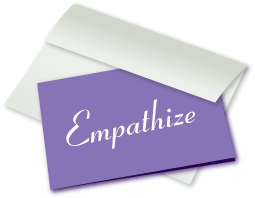

orget four weddings and a funeral. The words I've written have been at thousands of weddings, hundreds of funerals, and even more birthday parties than I can count. Since I began my career as a greeting card writer ten years ago, I've had the privilege of joining people at their happiest and saddest moments. That's one reason I chose this path. But along the way I've discovered that writing cards has given me a gift I didn't expect—the gift of empathy. Writing greeting cards helps me see the world through the eyes of others. I've never had a daughter, but I know what it's like to write for one. I've never lost a spouse, but I've written words to comfort someone who has.
I've laughed at the jokes about those “sappy Hallmark cards” along with everyone else because there's some truth in them. But an even greater truth is that when you become the vessel through which one person expresses themselves to another, there's something sacred in it. Of course, not all writers want to be greeting cards writers. But I believe that by learning to write greeting cards, every writer can gain a deeper compassion and empathy that will flow into whatever writing she chooses to do.
“The trick is saying a little that still means a lot.”
Start with the Heart
As you start writing greeting cards, it's easiest to begin with the people you love. Find a cozy spot, pull out a pad of paper, blank notes, or your trusty laptop. Think of someone who is close to you. You might choose a parent, sibling, or dear friend. Then put your pen to the paper or your fingers to the keyboard and simply begin to express your heart to that person. The trick is saying a little that still means a lot. Most greeting cards range from 25 to 75 words. That means you can't take pages to tell your reader how you feel. You've got to dig deep, speak simply, and share openly. This brevity is actually one of the benefits of using greeting cards as a writing exercise. As a writer, we can all fall in love with our own words. They become like our children, and what good mother wants to give away a child (at least one who is behaving and looks very nice on the page)? But greeting cards teach you to trim things down to the necessities.
“That's fine,” you may be saying. “But I'm having the opposite problem. I'm staring at this piece of paper and I don't have 25 to 75 words. I've got zip.” If that's you, it may help to think of a specific holiday or occasion to help you get inspired. Birthdays, Mother's Day, or Valentine's Day can be good places to start. Other general occasions include Encouragement, Get Well, and Friendship. By choosing an occasion or event for your card, it helps you understand that “why” behind it. It's like the frame on a picture.
If you've picked a frame and you're still struggling with what to put inside it, then think of a theme for your card. If you're writing a birthday card, then the theme of “celebrating you” would be appropriate. If it's Mother's Day, then love or appreciation would be great themes. After you know the main message you want to convey, it will be easier to get those 75 words down on paper and cut out what isn't really necessary.
You may be wondering how sharing your heart with your closest friends and family members is going to help you as a writer. There are actually several benefits to this specific exercise.

“...we can step out of our own realities and become deeper, richer (at least emotionally) writers.”
First, writing to those closest to you evokes emotion. We all have days when we sit down at the keyboard and our passion has gone out the window. We need to write something compelling, but all we can think of is how downright bored we feel at the moment. But if you start writing a greeting card to the person you love more than anyone in the world, you can bet those emotions are going to come revving up to the keyboard.
If you need to evoke a particular emotion for a piece you are doing, writing a greeting card can be a great way to get you in the mood. For example, if you're a fiction writer who's working on a wedding scene then you can pretend you're a young bride again and write a card to your husband. You don't have to give it to him—especially if he hasn't taken out the trash. But it will help you reconnect with those emotions so you can channel them into your current writing project. As writer Bharti Kirchner said, “Don't be afraid to transfer one or more emotional experiences of laughter, pain, or agony to your readers. They may curse you because they burned the rice, dropped their aerobics routine, and were late for work, but they won't put your book down.”
Another benefit of writing greeting cards to those you love, and the primary theme of this article, is that it builds empathy. If someone has lost a loved one, write a sympathy card. If your friend is battling cancer, write an encouraging card for her. One of the most important parts of being a writer is putting yourself in the shoes of another. But we all get busy and absorbed in our own little worlds. We can forget that there's more to life than the Times New Roman on our computer screen. By writing greeting cards as an exercise, we can step out of our own realities and become deeper, richer (at least emotionally) writers.

“...step out of your comfort zone into someone else's world.”
Expand Your Perspective
After you've written to friends and family, it's time to take a step out of your inner circle to embrace the world at large. This is your chance to find greeting card inspiration wherever you go. When I first became a greeting card writer, we went on retreats to a little bed and breakfast. We spent rainy afternoons thumbing through stacks of magazines. Our assignment was to write a card based on something that impacted us. You can do the same in your very own living room. If you read a story in a magazine about a woman who has lost her husband, write a card for her. Maybe a funny story will inspire you to write a humorous card. Perhaps a profound quote will land on the cover of your card and you'll add your own personal touch to the inside.
Magazines aren't the only way to get inspired. Television presents tons of opportunities too. Even reruns will work! If you're a Friends fan, write a card from Monica to Rachel. If you watch CNN and see a story about a fallen soldier, write a card to his father. Again, the most important part of this exercise is to teach you to get in touch with your emotions, be in tune with what your heart responds to, and step out of your comfort zone into someone else's world.
As you learn what touches your heart, you'll also learn what really matters to you as a writer. You respond intellectually to thousands of things every day. But there are probably far fewer situations or stories that truly grab your heart. Finding those is like uncovering treasure. As novelist Catherine Munch said, “Powerful emotions such as fear, grief and loss can open the way to some of your best work.”
Fortunately, positive emotions like love, joy, and excitement do the trick pretty well too.

“...if you want to reach
your readers, the surest way to do so is through the heart.”
Putting It All Into Practice
Now we're going to get into the practical side of how this applies to the most important writer in your world—YOU! Here is a list of how to apply write greeting cards as an exercise for different genres.
Fiction
If you're a fiction writer, one of the trickiest parts of the trade is getting into the heads and hearts of your characters. Writing greeting cards from one character to another can help you accomplish this feat. For example, suppose you're stuck figuring out exactly how your heroine feels about her alcoholic mother. You could write a Mother's Day card from your main character to her mom to find out. If you don't feel like you're ready for that, pop on over to a card shop and take a look at the rack. Which card would your character pick? Which ones would she stick out her tongue at after reading them? Does she like the long, serious cards or the short, sassy ones? You can find out a lot about someone just by the greeting cards that person picks. That's why greeting cards can help you get a handle on the relational dynamics between your characters in a new, creative way.
Novelist Madeleine Costigan described this kind of deep research into a character when she said, “The writer can't skate on the surface of a problem and hope to portray genuine emotion. Go to a character's deepest level, reveal the character intimately…As an editor once writer wrote to me when returning a manuscript—‘Nice writing, but it didn't get me in the heart, which is where I like to be got.’ ”
Non-fiction
One of the biggest challenges of non-fiction is truly staying in touch with your audience. It's easy for non-fiction to become impersonal and focus more on facts than feelings. But if you want to reach your readers, the surest way to do so is through the heart.
As a writing exercise, try writing a greeting card to a member of your audience. For example, perhaps you are writing a book for women battling depression. Make up a woman who will be reading your book. Give her a name, age, and other relevant characteristics. Describe her situation. Then write a card for her. What do you want to tell her? Do you want her to know she's valuable, encourage her to not give up, or provide spiritual truth to her? What you want to say most in your book or article will surface in this exercise. That's why in addition to evoking emotion and helping you connect with your audience, writing greeting cards can also help you clarify the key messages you want to convey.
If you'd like another twist to the exercise above, write to yourself from someone in your audience. What is she saying? Is she admiring you for your courage, thanking your for your humor, or praising you for your wisdom? If you know this, you will be a long way down the road to knowing who you want to be as a writer and how you want readers to respond to you.
If you're writing about a non-fiction topic you may not have experienced personally, this can be even more helpful. For example, if you're writing to divorced women and you've never been divorced, you'd better be able to step outside of your own life. Hearing personal stories helps, but we can often remain detached from them. By putting yourself in someone's shoes by writing to that person, it takes your understanding to a deeper level.
I still remember sitting on a picnic table outside our office with tears streaming down my faces as I wrote a card for a parent who had lost a child. While I had heard many stories of such losses, writing about it as if it had happened to me or someone I dearly loved put it in a totally different context. No one can fully understand such a loss, but I discovered a deeper compassion and empathy than I'd ever had before.
Poetry
Many people equate greeting cards with poetry, but the two are actually different. Poetry is often about something or someone while greeting cards are always to someone. There are exceptions, and by learning to write poems that lean more toward the greeting card category you can expand your repertoire. Love poems would be an example of poetry that is more like a greeting card. If your poetry tends to be on more general themes, greeting cards can help you shift to more personal, relational writing. When you write to someone rather than about something, it can add extra empathy and compassion to your words.

“The best way to begin writing
greeting cards is just to
take the plunge.”
New Markets
Hopefully, as writers we're always stretching our wings and growing. That means you'll be stepping into new territory on a regular basis. Each market or publication has its own culture. It's similar to going to a new country. We've all heard it said that the best way to learn a language is to live there. It's one thing to read about French while sitting on your couch at home and quite another to speak it on the streets of Paris. Studying up on your market or publication is a bit like learning French at home. Of course, it's very important and valuable. But actually taking the plunge and going there is something different entirely. Writing greeting cards as an exercise when you enter a new market is very similar. As Creative Strategist Jason Rovenstine said, “You have to understand or empathize with the subject before you can create for it.”
Perhaps you've just landed an article for a bridal magazine and you've yet to tie the knot. You can read all about brides, or you can activate the imagination you've had since you were a little girl and write a greeting card as if you are the bride. Pretend the wedding is over and you are sitting down to write thank you notes to the wedding party. What do you say? What meant the most to you? An exercise like this can help you go a long way toward stepping into those white, high-heeled, Cinderella shoes as a writer.
Getting Started
The best way to begin writing greeting cards is just to take the plunge. Write from your heart and don't worry about whether or not it sounds anything like the cards you see in stores. Hallmark writers Angela Ensminger and Keely Chace said in their book On a Personal Note: A Guide to Writing Notes with Style, “You're not going to turn into a note-writing Olympian overnight. Nobody expects that, and you'll just stress yourself out trying. Instead, consider approaching it like any skill-based endeavor—start slowly and build up.”
Here are a few quick ways to start incorporating cards into your writing routine:
- For each holiday, write one card of your own and send it to someone you love.
- For every writing project you tackle, jot down a quick card that relates to it for inspiration.
- Once a week, write a card for a current event, television show, or article that touches your heart. Keep these in a file as idea starters for future writing projects.
- Buy greeting cards that appeal to you as prompts and then add your own meaningful messages.
- Purchase or create blank note cards to have on hand whenever inspiration strikes.
Conclusion
Greeting cards have often been considered the cotton candy of the writing world. But beneath all the sweetness and fluff, there's a lot of substance. I learned this as never before when we created a card line called In Time of Need. It dealt with issues such as depression, addiction, unexpected loss and other challenging situations. It pushed me out of my comfort zone. But it also helped me learn, grow, and become more compassionate. One of the best things about being a writer is that when you grow in your profession, you also grow as a person too. Greeting cards are one doorway to that growth, and I invite you to walk through it with your arms and heart open wide.

Holley Gerth is a writer and creative manager for DaySpring, a subsidiary of Hallmark (www.dayspring.com). She recently published her first book, The Greatest Shepherd of All. She is also a regular contributor for Zia magazine (www.ziamag.com). Holley shares her heart and home with her husband Mark and a very silly dog named Katie.